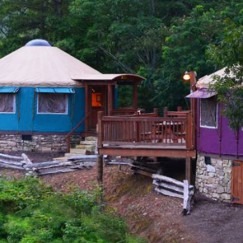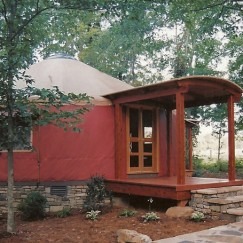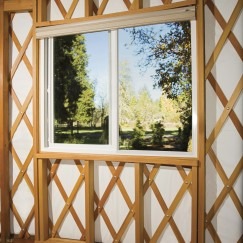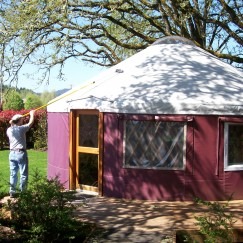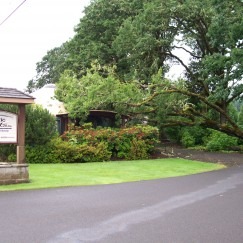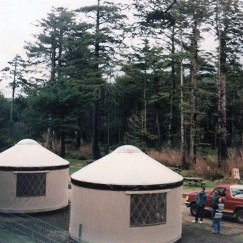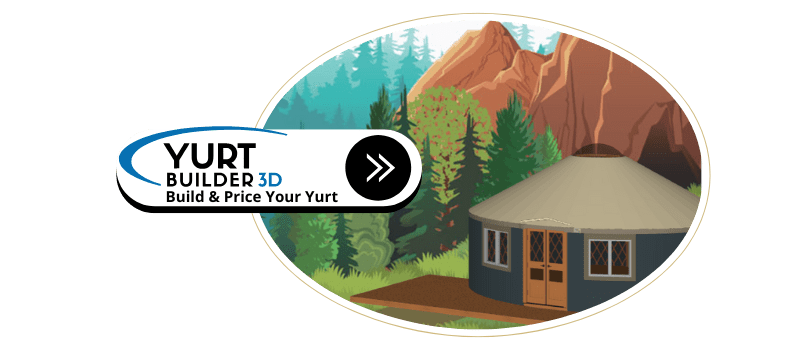Customer Spotlight: Orca Island Cabins
When Dennis and Susan Swiderski acquired three acres of property on the iconic Orca Island’s shoreline, the last thing they expected to do was start an exciting vacation destination like Orca Island Cabins. Between a career in law and the growth of their family, their interest in ecotourism was sparked by their passion for Alaska’s beauty, leading to their desire to share it with visitors from all over the world. Since opening in 2004, their eight yurt cabin system has become one of the best glamping destinations in the country. Today, Orca Island Cabins is owned and operated by Dennis and Susan’s son Jonah and his wife, Yen Ly. We asked our longtime friends Dennis and Susan to share their incredible yurt-building journey and what it’s like to stay there.
Arriving in Alaska: The Start of an Adventure
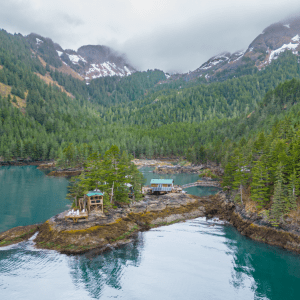
Susan, an artist by profession, came to Alaska from New Mexico with her family in 1969. Dennis came to Alaska from Washington, D.C., in 1977, where he was a lawyer with the Federal Communications Commission (FCC). After meeting in Anchorage, Susan and Dennis married and had three sons, moving to Seward, Alaska in 1996. After acquiring three acres of waterfront property (including a small island that they named Orca Island), the couple decided to build a remote wilderness lodge that now includes eight luxury Pacific Yurts they later named Orca Island Cabins.
The Construction of Orca Island Cabins: Dennis and Susan Meet Pacific Yurts
As Dennis and Susan developed their plans to start their waterfront vacation destination, they felt a strong desire to make their property eco-friendly. In the mid-1990s, ecotourism was a relatively new concept, but with so much natural beauty in Alaska, the couple committed to preserving the acreage they owned by approaching development sustainably.
Enter Pacific Yurts. After being introduced to Pacific Yurts by a friend, the couple immediately liked the sustainable design, ease of assembly, and the minimal impact that yurts would have on the island’s fragile and mossy topsoil. They decided to build their yurts as an experiment, knowing they could easily replace the structures with something more traditional should the project go south. Luckily, the responses they’ve received from their guests have been wholly ecstatic and met with positivity.
The Process of Building Pacific Yurts on Orca Island
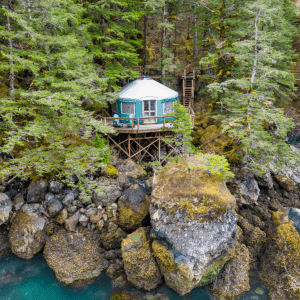
Dennis and Susan started Orca Island Cabins in the early aughts with a single yurt. They initially anticipated building four, but they’ve since built eight that are now connected to the island by an 80-foot arched footbridge. Initially, the couple chose the 20-foot diameter yurt because it could comfortably accommodate two guests with a queen bed and futon (for additional guests), private bathroom with compost toilet, kitchen, living, and dining areas. Thus, Orca Island Cabins was born as a seasonally run business after finishing that initial yurt.
The Challenges of Building Pacific Yurts on an Island
Because the Swiderski’s lodging is located in a remote setting (ten miles SE of Seward, Alaska in Resurrection Bay), all building materials were brought into Orca Island by boat. The temperate and wet climate, which included frequent high winds and strong seas near the island, made it more difficult to access the property and to build on it at the time.
They hired local Seward carpenters who knew how to work on the terrain to assemble their yurts. They built the foundation in five to six days, the deck in four to five, and erected the first yurt in two days. The interior took another ten days to finish, which included adding a bathroom, full kitchen, and propane for hot water, along with a range fireplace and other luxury yurt amenities for guests.
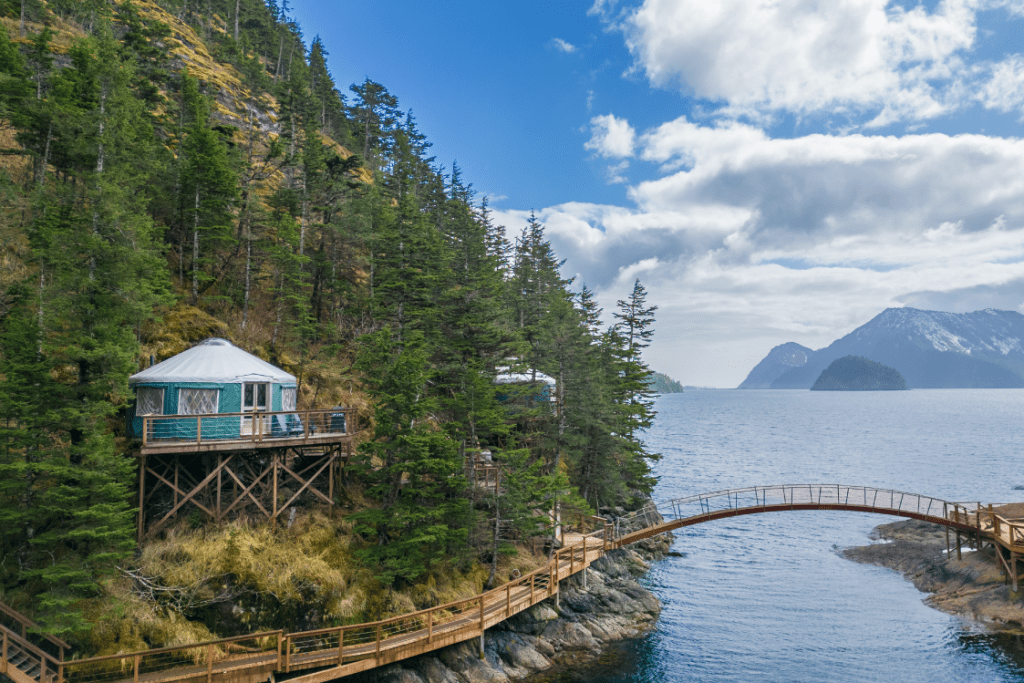
Operating a Yurt Glamping Business Q&A
As pioneers of glamping in Alaska, the Swiderski family has witnessed the skyrocketing popularity of the industry over the years, updating their own services and systems in order to stay competitive while adhering to eco-friendly standards. We asked Dennis, Jonah, and Yen about owning and operating their exciting and remote vacation destination. Here’s what they told us.
How has your experience been with Pacific Yurts, and how have guests taken to the structures?
Dennis: I would simply emphasize that it is important to erect any yurt per the instructions. As far as living off the grid goes, because we embraced, from the outset, ecotourism and sustainable energy practices, we have emerged as an example of a “glamping” destination, i.e., an upscale, comfortable, and stylish rental destination in a remote, wilderness setting. However, because we are off the grid, we rely on solar panels/inverters/battery banks for our limited electrical needs, along with a generator as a backup. We utilize propane for our range, as well as a fireplace and a water heater. We also transport all of our water to the island by boat. As far as maintenance goes, we stain the doors and wash the outside every summer, while the insides get a deep cleaning every spring
What is your average occupancy rate for your 8 yurts?
Jonah and Yen: Over the years, we have experienced a 75% occupancy rate. During 2021 and 2022, Alaska had a huge boom in business because international travel was still highly restricted but people wanted to get out. The numbers we are seeing now are more reflective of stable growth and we are aiming to stay in the 85-95% range.
How many rental nights does Orca Island Cabins offer per year?
Jonah and Yen: We are open from mid-May to mid-September. The exact opening dates differ each season due to weather and other factors, but we base our budgets and systems on a 100-day season. In reality, it is more like 120-125 days but shoulder season dates are very open and often have inclement weather limitations. June, July, and August are our busiest months, with July being the peak month.
What is an estimate of the average ROI of one of your yurts?
Jonah and Yen: The cost of the yurt building, construction of the platforms, and connecting walkways more than triples the costs of the original purchase. We do not generally see any return on the investment when building on Orca Island Cabins for a full season. But at our current rates, it makes up two-thirds of their cost per season.
Yurt Lodging Tips from Orca Island Cabins
If you’re looking to start a yurt glamping business, here are a few tips from Orca Island Cabins.
- Give ample surrounding space around each yurt. Yurts are essentially very elaborate tents and because of their soft shell, all outside noises are heard and all inside noises are projected.
- The right tools make a big difference. The most difficult part of the maintenance is the cleaning of the inside walls due to the lattice structures.
- Get the insulation package to help retain heat. Because of the vaulted ceilings and wall materials, we are very glad we went with the insulation package to combat this. We also put fans on top of our propane stoves to help distribute heat.
